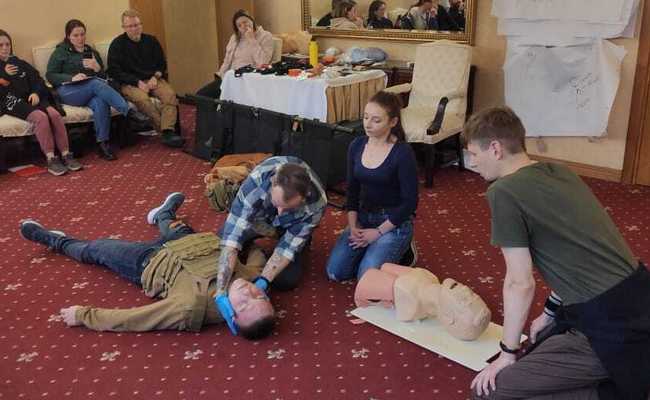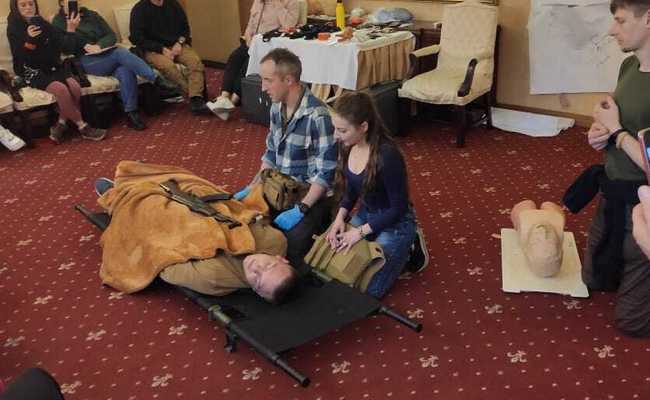Everyone has to perform the procedures – providing aid for injuries, stopping the bleeding with a CAT tourniquet and a haemostatic dressing. You can’t conduct that in a large group of people – recounts Anna Zawiślak, the coordinator of the fundraiser for Ukraine organised by the Institute for Emergency Medicine and Medycyna Praktyczna and a co-organiser of the training courses organised by the Institute in Lviv.

When did it become clear that the medical support in the form of equipment shipments isn’t enough?
Very early on. Every time we identified the needs or delivered the equipment, we had to conduct a series of talks between Ukrainian doctors and our experts. They provided counsel and instructions on how to properly use the provided tools. I don’t meant to imply that Ukrainian doctors have to be taught everything from scratch. It’s not like that. The talks happen because we care and we want to provide the best possible help. Many times it turned out that apart from the things we were asked for, some additional items were still needed.
External fixators are the best testament to the fact that every piece of equipment needs to be carefully analysed and discussed. Everyone needed external fixators, as many as possible. We know that they’re required, we’re not denying that, but there are many types of those devices – for short bones, long bones, pelvis. Together with Isaiah Mission Foundation, orthopaedists from the US and Ukraine, and our experts, we came up with a design for a universal fixator. Then we sent devices built according to that design to the battlefront.
You’re not just deliberating. You’re also organising courses. Who participates in those?
So called “normal people”. Since the very beginning of the war we’ve been sending specialised equipment for the doctors, surgeons and paramedics, as well as the resources that are being used by people without medical education. I’m mainly talking about CAT tourniquets – extremely needed tourniquets that stop massive bleedings. They save lives. So we decided to teach people how to use them. Thanks to the grant provided by Americares, we’ve designed a training program, and we’ve just finished our second course. We based our training on the items that we took from the certified TCCC (Tactical Combat Casualty Care) and ITLS (International Trauma Life Support) training courses which cover life-saving procedures in the pre-hospital care, that is battlefield medicine, and then adjusted them for our conditions. Most of the people who participate in our courses have no medical education – they’re teachers, volunteers from local self-help groups. Our goal is to train them in such a way, they’ll be able to pass the acquired skills on, teaching another set of people. It is, de facto, a training course for instructors. Every participant is given a supply of tourniquets. The specific number depends on training capabilities of the particular person – how many people will they be able to train on their own turf.

How do you find the participants?
We’re assisted by a public organisation called Innovation University. Its members help in various educational projects and thus have a lot of experience in the matter. With their help we’re reaching various volunteer groups, conducting registration, and contact the participants. We’re also making use of our connections in hospitals and paramedic teams who work near the battlefront. The participants of our last training course came from Kryvyi Rih and Kharkiv, among other places.
How many people participate in one training course?
The course is meant for 20 people. We’re being restricted by the number of instructors and the fact that the course includes practical training. Everyone has to perform planned procedures – providing aid for injuries, stopping the bleeding with a CAT tourniquet and a haemostatic dressing. You can’t conduct that with a large group of people.
Where is the course happening?
In one of the Lviv hotels. It’s a practical solution. The course lasts 2 days. The participants and instructors can sleep in the same place.

Are the instructors Polish?
The course is conducted by the instructors from the Institute for Emergency Medicine with the assistance from our colleagues – ITLS instructors from Ukraine. The most involved member of the Institute is Eryk Madej who helped prepare the course and is its acting director. Ukrainian instructors also act as translators for the participants. Not all of them speak English.
Do the participants need to pay?
The course is completely financed by the Americares grant, which also covers the purchase of the CAT tourniquets given to the participants for the purposes of teaching other people. One high-quality tourniquet, and that’s the only kind we use, costs somewhere around 200 PLN.
Are you considering expanding those courses?
We have another course prepared already. Also sponsored by the Americares grant. This time we’ll be training medical staff. It stars on the 15th of October. It’s a medical rescue ultrasound training course. We want to teach how to quickly diagnose trauma and how to use the eFAST protocol which detects free fluid in the peritoneal cavity, pleural cavities, and pericardium in patients who suffered trauma. During the course we’ll be using a handheld portable Butterlfy IQ ultrasound machine, which you can plug in to your smartphone. We invite battlefront hospitals staff and mobile paramedic units to participate in our course. A portable ultrasound machine is extremely helpful in deciding who should be evacuated first, for example. It’s the fastest and the simplest method to assess internal injuries in the out-of-hospital conditions.













